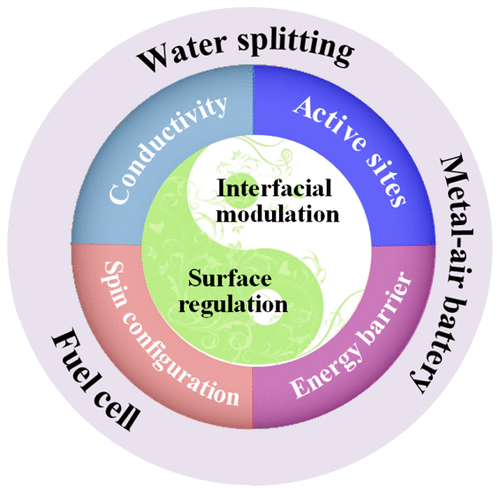当前位置:
X-MOL 学术
›
Acc. Chem. Res.
›
论文详情
Our official English website, www.x-mol.net, welcomes your feedback! (Note: you will need to create a separate account there.)
Surface/Interfacial Engineering of Inorganic Low-Dimensional Electrode Materials for Electrocatalysis
Accounts of Chemical Research ( IF 18.3 ) Pub Date : 2018-10-30 00:00:00 , DOI: 10.1021/acs.accounts.8b00266 Pengzuo Chen 1 , Yun Tong 1 , Changzheng Wu 1 , Yi Xie 1
Accounts of Chemical Research ( IF 18.3 ) Pub Date : 2018-10-30 00:00:00 , DOI: 10.1021/acs.accounts.8b00266 Pengzuo Chen 1 , Yun Tong 1 , Changzheng Wu 1 , Yi Xie 1
Affiliation

|
Exploitation of highly active and cost-effective electrode materials for the design of new types of renewable energy storage and conversion systems has been tremendously stimulated by the higher attention being paid to global energy security and invention of alternative clean sustainable energy technologies. Low-dimensional solid materials with special atomic and electronic structures are deemed desirable platforms for establishing clear relationships between surface/interface structure characteristics and electrocatalytic activity, representing enormous potential in the pursuit of high-performance electrocatalysts. Recent achievements revealed that surface and interfacial atomic engineering is capable of achieving novel physical and chemical properties as well as superior synergistic effects in inorganic low-dimensional nanomaterials for electrocatalysis. Compared to bulk counterparts, the electronic structure in the surface of inorganic low-dimensional nanomaterials is more sensitive to and can thus be regulated more easily by surface and interfacial modification strategies, resulting in greatly optimized electrocatalytic performance.
中文翻译:

用于电催化的无机低维电极材料的表面/界面工程
由于人们对全球能源安全和替代性可持续清洁能源技术的高度重视,极大地刺激了开发高活性和高性价比电极材料用于新型可再生能源存储和转换系统的设计。具有特殊原子和电子结构的低维固体材料被认为是在表面/界面结构特征与电催化活性之间建立清晰关系的理想平台,在追求高性能电催化剂方面具有巨大潜力。最近的成就表明,表面和界面原子工程能够在用于电催化的无机低维纳米材料中实现新颖的物理和化学性质以及优异的协同作用。与块状对应物相比,无机低维纳米材料表面的电子结构对表面更敏感,因此可以通过表面和界面改性策略更容易地对其进行调节,从而极大地优化了电催化性能。
更新日期:2018-10-30
中文翻译:

用于电催化的无机低维电极材料的表面/界面工程
由于人们对全球能源安全和替代性可持续清洁能源技术的高度重视,极大地刺激了开发高活性和高性价比电极材料用于新型可再生能源存储和转换系统的设计。具有特殊原子和电子结构的低维固体材料被认为是在表面/界面结构特征与电催化活性之间建立清晰关系的理想平台,在追求高性能电催化剂方面具有巨大潜力。最近的成就表明,表面和界面原子工程能够在用于电催化的无机低维纳米材料中实现新颖的物理和化学性质以及优异的协同作用。与块状对应物相比,无机低维纳米材料表面的电子结构对表面更敏感,因此可以通过表面和界面改性策略更容易地对其进行调节,从而极大地优化了电催化性能。


























 京公网安备 11010802027423号
京公网安备 11010802027423号